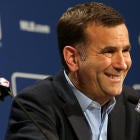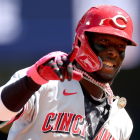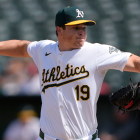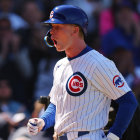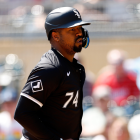By now you know that the White Sox starting with the run-up to the 2017 season undertook an almost complete teardown, and the early returns on said teardown have been highly promising. Added to the system via trade in recent months are high-ceiling talents like Yoan Moncada, Eloy Jimenez, Michael Kopech, Reynaldo Lopez, Lucas Giolito, Blake Rutherford, Luis Basabe, and ... we could go on. Add those names to a few promising youngsters already in the fold (Luis Robert, most notably), and the White Sox have an excellent long-term outlook.
Eliminated from contention and presently on pace for 97 losses, the club is squarely focused on the future.
Speaking of which, Sox GM Rick Hahn and his lieutenants, for all the good work they've done during this rebuild, still have some critical decisions to make -- decisions that will have a bearing on whether the club realizes the potential they've been assiduously building. Specifically, three forthcoming decisions stand out. To wit ...
1. Do you trade Jose Abreu?
The 30-year-old slugger is enjoying quite a renaissance. In 2017, he's batting .308/.359/.559, which translates to an OPS+ of 142, with 31 homers.
That's big because Abreu was showing signs of decline prior to this season. In his excellent rookie campaign of 2014 he put up an MLB-leading 173 OPS+. That figure dropped to 135 in 2015 and then to 125 in 2016.
This season, however, he's reversed course to an impressive extent. These also look like genuine improvements. This season, Abreu's increased his fly-ball rate while also increasing his percentage of hard-hit balls. In related matters, Abreu's doing a much better job in 2017 of laying off pitches outside the strike zone. That all makes his improved production -- and halted decline -- understandable and perhaps sustainable.
To get a better handle on the sustainability of Abreu's 2017 gains, we'll turn to an advanced metric called expected weighted on-base average (xwOBA). xwOBA grows out of wOBA, which assigns proper value to every possible offensive event that happens while a batter is at the plate. Those proper valuations of singles, doubles, homers, walks, etc., distinguish wOBA from more traditional measures like AVG, OBP, and SLG. Also, for simplicity wOBA is scaled to look like OBP, which means that, say, .400 is elite and .290 is pretty poor. For instance, Babe Ruth is the all-time leader with a patently absurd wOBA of .513.
All of that brings us back to xwOBA, which is an estimation of what a hitter's wOBA should be based on things like exit velocity off the bat and launch angle. xwOBA attempts to strip away luck -- bad or good -- and defensive play from wOBA and identify a hitter's baseline skill. It's useful for getting an idea of how a hitter figures to perform in the near-term future. Basically, if a hitter's xwOBA is significantly lower than his wOBA, he's probably going to come back to earth at some point. On the other side of things, if a hitter's xwOBA is quite a bit higher than his wOBA, then better days are likely ahead. There's some evidence that slower players tend to underperform relative to their xwOBA and faster players tend to overperform, but even so xwOBA has utility. Here's more on wOBA, and here's more on xwOBA.
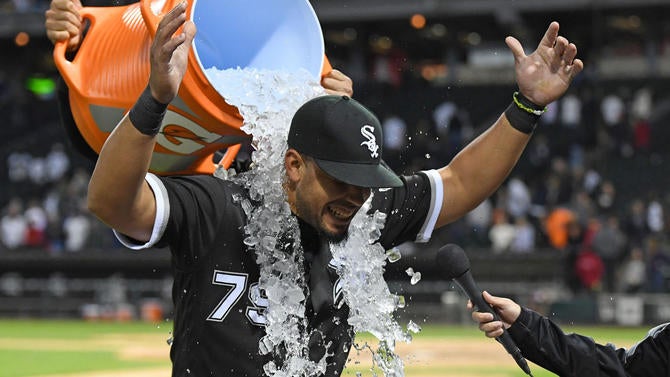
This brings us back to Mr. Abreu. At this writing, his wOBA (.391) exceeds his xwOBA (.364) by 27 points. While .364 is still a strong mark and constitutes improvement over his actual outputs last season, it does suggest that some good fortune has been at work. That's something for the Sox to think about when it comes to Abreu's future with the organization.
Speaking of which, this past offseason Abreu opted out of the three years and $34 million left on his contract and instead chose to go year-to-year in arbitration until he's eligible for free agency after the 2019 season. Coming into this year, he settled with the White Sox on a salary of almost $11 million, and given his 2017 bestowals -- lucky or not -- he's going make a lot more than that in 2018. In other words, Abreu was almost certainly wise to bet on himself and forego that guaranteed $34 million.
But the Sox must determine whether they think Abreu can be productive the next time they're ready to contend, which figures to be 2019 at the earliest. He's on the wrong side of 30, and there's that xwOBA-wOBA deficit noted above. On the other hand, he's a very popular player, and the simple reality is that he's having a big year. Abreu probably isn't going to net the Sox a huge haul in trade -- teams these just aren't paying a lot in terms of talent or dollars for bat-only players -- but he'd bring something. They've got a lot high-ceiling, low-floor types in the system, and Abreu could bring them back controllable depth pieces. That's something they can use.
In the end, you can marshal a compelling case that the Sox could go either direction with Abreu. Which one they choose will play an obvious role in the future of the organization.
2. Do you trade Avisail Garcia?
It's a similar dilemma when it comes to Garcia and his breakout season.
Coming into 2017, Garcia had a line .258/.310/.385 in 409 big-league games while providing negative value in the field and on the bases. Given that Garcia was the Sox's centerpiece of the 2013 trade that sent Jose Iglesias to Detroit and Jake Peavy to Boston, his development had been a big disappointment.
This season, though, things changed. Right now, Garcia owns a slash line of .333/.380/.509 (137 OPS+).
In Garcia's case, his xwOBA for 2017 is shy of his actual wOBA by a hefty 36 points (.350 to .386). Moving forward, that's a potential source of concern. Overall, you're seeing some signs of a more aggressive approach. He's swinging more often, hitting the ball in the air a bit more, pulling the ball more, and trading weak contact for medium contact. Those things can all explain some improvement but maybe not the entire xwOBA-wOBA disconnect.
The sensible middle ground seems to be that Garcia has reached a new level, but he may regress a bit from his current heights. As such, do the Sox consider parting with him now while his numbers are up?
Garcia's 26 and capable of getting by at an outfield corner. He's also not eligible for free agency until after the 2019 season. GIven that he's still fairly young, it's reasonable to think he can help the Sox by the time they're ready to matter. On the other hand, it's tempting to move him coming off his breakout year. As with Abreu, it's not an easy decision.
3. Who's your high 2018 draft pick?
A secondary benefit of rebuilding/tanking is the lofty draft pick. If current paces hold, then the Sox will have the No. 3 overall pick in the June 2018 First-Year Player Draft. That would be their highest slot since 2014, when they selected Carlos Rodon. Before that, you must go to back all the way to 1977 to find a Sox pick within the top three overall. Speaking broadly, the Sox haven't gotten good returns from their recent top picks. There's the occasional exception, of course, but they need to nail this one.
It's early, but right now the top three 2018 draft prospects are looking like University of Florida right-hander Brady Singer, California prep shortstop Brice Turang, and Oregon State infielder Nick Madrigal. Not that it's ever a good idea to draft for need in a sport like baseball, but the Sox, since they have a nice mix of positional and pitching prospects, can go the obvious "best player available" route. Maybe they want one of those college talents so that they'll reach the majors early within their coming span of contention.
What they don't want to do is, um, keep winning games so that they fall behind the Tigers, Mets, and or Reds in the draft order. Tank with purpose, people.
With regard to these three semi-pressing matters, we may not know until well into the 2018 season how the Sox will play any of them, but those decisions will tell you much about where the Sox think they're going and how soon they'll get there.













